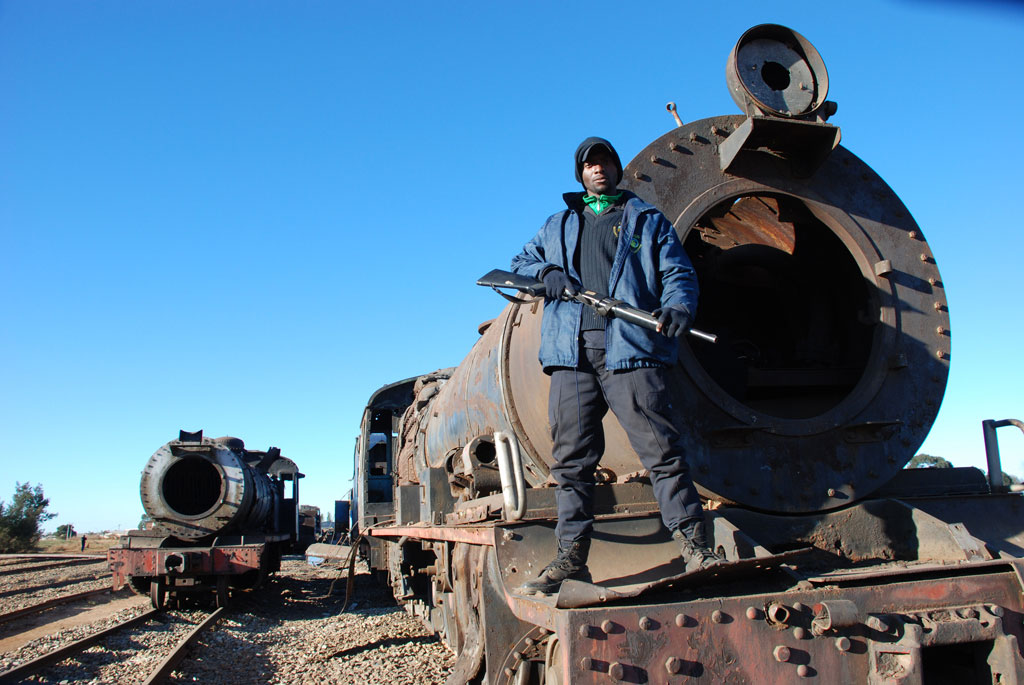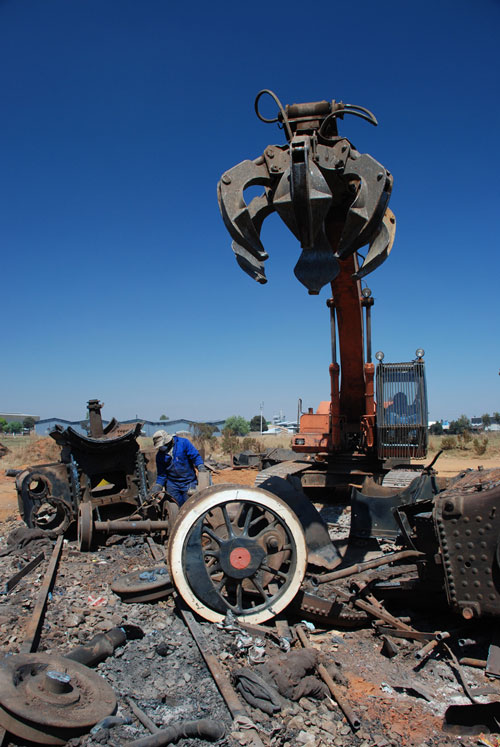The 27 locomotives, which belonged to South African National Rail and Steam Museum, a nonprofit preservation group, were gifts from the former South African Railways and various mining houses and industries that had once used them on their private railways. The collection had been stored on tracks on an open space near an industrial township west of Johannesburg.
Some of the locomotives dated back to the late 19th century and included sole survivors of their type.
Museum secretary Mike Dyke told TRAINS that visitors to the Chamdor site two weeks ago saw thieves with professional cutting equipment torching parts from the locomotives in broad daylight.
“Our own security people were chased away by scrap thieves wielding firearms,” Dyke said. Police allegedly told the museum they could do nothing.
The museum is little more than a stretch of reclaimed mining land next to a rapidly growing informal settlement.
Metal theft is an endemic problem in the country where unemployment tops 25 percent and much of the population lives in poverty. National rail operator Transnet Freight Rail loses almost half a mile of overhead catenary wire every day to scrap thieves, resulting in delayed and cancelled trains as sections of the electrified network are closed for repair.
Railfans, angry that the preserved locomotives were not guarded, said the museum had been previously warned that the locomotives were at risk from thieves. Dyke said museum officials had applied to government for funds to build a wall around the site but had been rebuffed.
Following the reports that illegal scrapping was taking place, the museum was quoted 25,000 rand (about $3,570) a day to place 24-hour armed guards on the site. A survey showed the locomotives were too badly damaged to restore; in most cases the thieves had cut the frames to get at the valuable brass and bearing in the axle boxes, and museum officials called in local recycling firm Reclam to cut up what was left. “There was no alternative,” Dyke said.
At Chamdor, scrapping is proceeding rapidly. Amid the swirling dust and smoke and the hiss of cutting torches, four guards with shotguns patrol the site night and day, keeping the scrap thieves at bay.
“More than 40 guys ran away when we arrived, leaving all their tools behind,” said Reclam Outside Projects Manager Mathew Spangenberg. “We told them to come back at collect their tools. As they did so they said they would be back later with 9mm pistols.”
The company expects to finish the job by Monday. “We are doing it as quick as we can,” he said.
The museum plans use the proceeds to improve the security for other its remaining steam locomotives that are stored at other sites.
South African rail preservation groups battle with shortages of funds and volunteer labor, and many restoration projects are unlikely to ever be completed.
“There are just too many locomotives out there,” said Chris Janisch, chairman of the Heritage Rail Association of South Africa. “There are enough resources to save a limited number. The rest must go, in the name of saving the others.”
While rail tourism was growing business worldwide, Janisch noted that locally rail heritage, with its colonial echoes, had become a political hot potato that nobody wanted to handle. He said the association has tried lobbying the country’s tourism officials. “But we can’t even get an interview [with the tourism minister],” he said.
The scrapping debacle comes shortly after the Passenger Rail Agency of South Africa, the country’s state-run passenger train operator, announced that it was suspending all long-distance passenger trains pending a review of their viability. Officials there blamed the suspension on a pricing dispute with Transnet Freight Rail for maintenance work carried out on its locomotives and passenger cars. Some 25 trains were affected, including the semi-luxury Premier Classe trains, which are popular with tourists.
Some train schedules between Johannesburg and the port cities of Durban and Cape Town have been restored, while bus services have been introduced on other routes.
South Africa once boasted a countrywide passenger train network until sweeping timetable cuts began in mid-1980s. Since then, rail passenger traffic has been further eroded by minibus taxis; cheap, long-distance coaches; and the startup of three low-cost airlines.
PAUL ASH is a career journalist with the Sunday Times newspaper in Johannesburg, South Africa. He writes about travel, transportation, and agriculture, and in his leisure time, he kayaks and photographs railroads.
The 27 locomotives, which belonged to South African National Rail and Steam Museum, a nonprofit preservation group, were gifts from the former South African Railways and various mining houses and industries that had once used them on their private railways. The collection had been stored on tracks on an open space near an industrial township west of Johannesburg.
Some of the locomotives dated back to the late 19th century and included sole survivors of their type.
Museum secretary Mike Dyke told TRAINS that visitors to the Chamdor site two weeks ago saw thieves with professional cutting equipment torching parts from the locomotives in broad daylight.
“Our own security people were chased away by scrap thieves wielding firearms,” Dyke said. Police allegedly told the museum they could do nothing.
The museum is little more than a stretch of reclaimed mining land next to a rapidly growing informal settlement.
Metal theft is an endemic problem in the country where unemployment tops 25 percent and much of the population lives in poverty. National rail operator Transnet Freight Rail loses almost half a mile of overhead catenary wire every day to scrap thieves, resulting in delayed and cancelled trains as sections of the electrified network are closed for repair.
Railfans, angry that the preserved locomotives were not guarded, said the museum had been previously warned that the locomotives were at risk from thieves. Dyke said museum officials had applied to government for funds to build a wall around the site but had been rebuffed.
Following the reports that illegal scrapping was taking place, the museum was quoted 25,000 rand (about $3,570) a day to place 24-hour armed guards on the site. A survey showed the locomotives were too badly damaged to restore; in most cases the thieves had cut the frames to get at the valuable brass and bearing in the axle boxes, and museum officials called in local recycling firm Reclam to cut up what was left. “There was no alternative,” Dyke said.
At Chamdor, scrapping is proceeding rapidly. Amid the swirling dust and smoke and the hiss of cutting torches, four guards with shotguns patrol the site night and day, keeping the scrap thieves at bay.
“More than 40 guys ran away when we arrived, leaving all their tools behind,” said Reclam Outside Projects Manager Mathew Spangenberg. “We told them to come back at collect their tools. As they did so they said they would be back later with 9mm pistols.”
The company expects to finish the job by Monday. “We are doing it as quick as we can,” he said.
The museum plans use the proceeds to improve the security for other its remaining steam locomotives that are stored at other sites.
South African rail preservation groups battle with shortages of funds and volunteer labor, and many restoration projects are unlikely to ever be completed.
“There are just too many locomotives out there,” said Chris Janisch, chairman of the Heritage Rail Association of South Africa. “There are enough resources to save a limited number. The rest must go, in the name of saving the others.”
While rail tourism was growing business worldwide, Janisch noted that locally rail heritage, with its colonial echoes, had become a political hot potato that nobody wanted to handle. He said the association has tried lobbying the country’s tourism officials. “But we can’t even get an interview [with the tourism minister],” he said.
The scrapping debacle comes shortly after the Passenger Rail Agency of South Africa, the country’s state-run passenger train operator, announced that it was suspending all long-distance passenger trains pending a review of their viability. Officials there blamed the suspension on a pricing dispute with Transnet Freight Rail for maintenance work carried out on its locomotives and passenger cars. Some 25 trains were affected, including the semi-luxury Premier Classe trains, which are popular with tourists.
Some train schedules between Johannesburg and the port cities of Durban and Cape Town have been restored, while bus services have been introduced on other routes.
South Africa once boasted a countrywide passenger train network until sweeping timetable cuts began in mid-1980s. Since then, rail passenger traffic has been further eroded by minibus taxis; cheap, long-distance coaches; and the startup of three low-cost airlines.
PAUL ASH is a career journalist with the Sunday Times newspaper in Johannesburg, South Africa. He writes about travel, transportation, and agriculture, and in his leisure time, he kayaks and photographs railroads.















